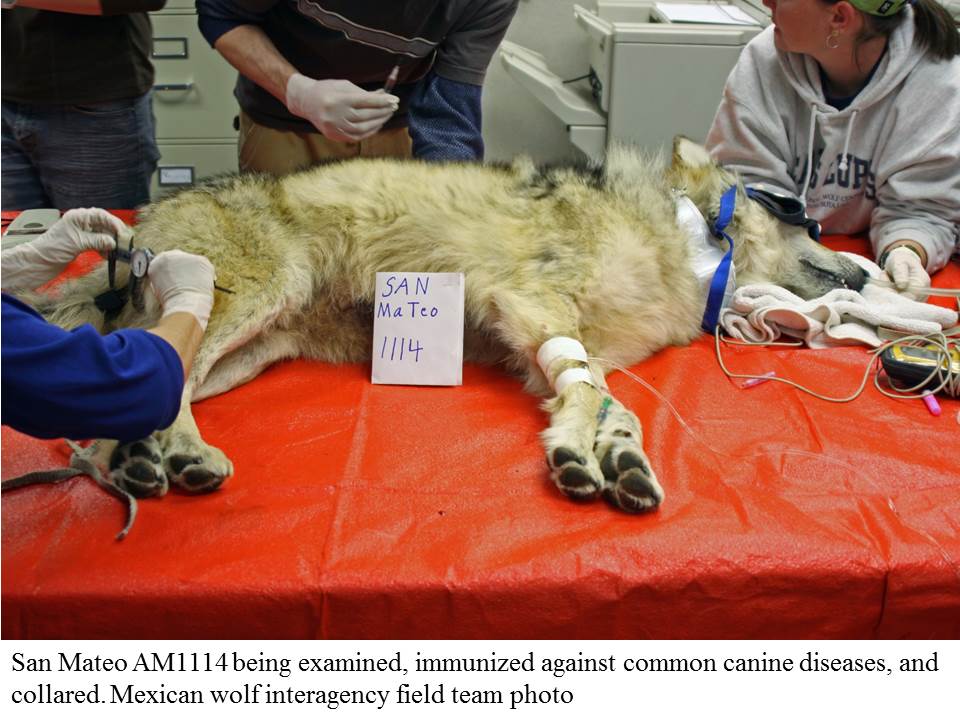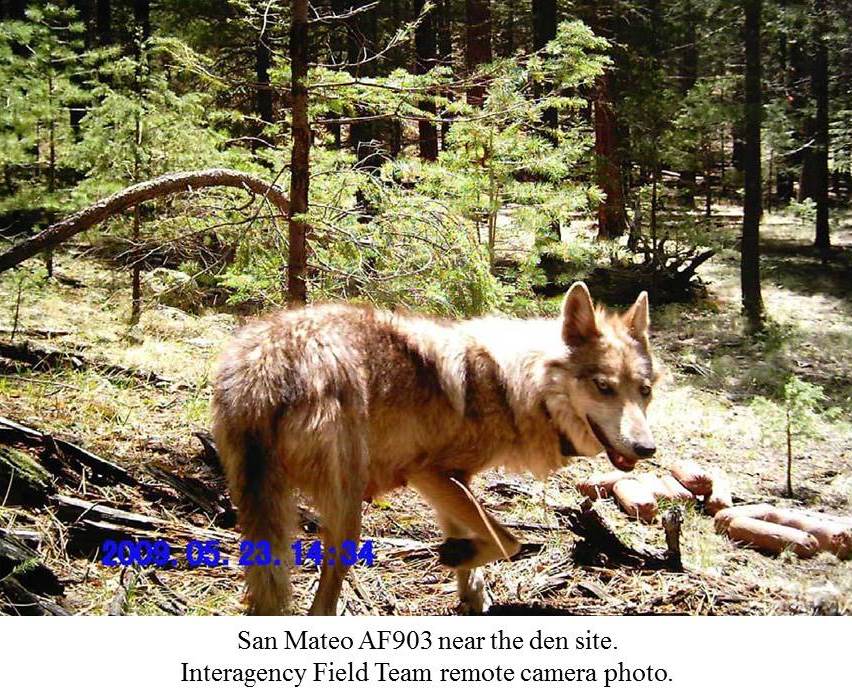Lobo Biography #12: AF903, A wolf with staying power.
Our story so far: In the winter of 2004, two wild-born Mexican gray wolves, M796 from Arizona, and F903 from New Mexico, found each other in the rugged San Mateo Mountains. The pair, named the San Mateo Pack, remained together, maintaining a home territory and producing pups, until early 2007, when M796 was fatally shot by the Mexican wolf field team for killing three cows in 365 days. His mate spent several months wandering alone. By the time of the 2007 end of year population survey conducted in January 2008, she had found a new mate. Read all pf Part 1 here.
 Undaunted by the loss of her mate, San Mateo AF903 wandered widely during the summer and fall of 2007. During the end of year population survey in January 2008, the Mexican wolf interagency field team captured and collared a male wolf who had begun traveling with AF903 and gave him the number M1114. DNA analysis later revealed that he was an uncollared yearling lobo who was never captured when his entire Hon Dah Pack family was removed from the wild for livestock conflicts in 2006.
Undaunted by the loss of her mate, San Mateo AF903 wandered widely during the summer and fall of 2007. During the end of year population survey in January 2008, the Mexican wolf interagency field team captured and collared a male wolf who had begun traveling with AF903 and gave him the number M1114. DNA analysis later revealed that he was an uncollared yearling lobo who was never captured when his entire Hon Dah Pack family was removed from the wild for livestock conflicts in 2006.
AF903 and her new mate established a territory that included parts of the Gallo and Mangas Mountains in the northeastern part of the recovery area. Soon they found themselves in trouble with the cattle that graze much of our public land in the area, especially in the spring and summer months.
By September AM1114 had been charged with killing four head of cattle. Under a policy in effect at the time, the U.S. Fish and Wildlife Service issued a “management decision,” to remain in effect for 45 days, authorizing the immediate translocation of AM1114 to the Gila Wilderness. If he returned to his mate and home range after being caught and moved, he would immediately be removed from the wild. The field team was unable to capture the elusive lobo, however, and the order expired on October 27. A 14-day extension of the order by USFWS Regional Director Benjamin Tuggle ended with AM1114 still wild and free. Sadly, although AF903 was thought to have denned in the spring, the 2008 end of year survey of the wild lobo population was unable to confirm the presence of pups, although one uncollared wolf was accompanying the two San Mateo adults.
 The first few months of 2009 were relatively uneventful for the San Mateo pair. According to telemetry flight reports, by late April the pair had settled down west of Mangas Mountain, in an area of huge, old, red-barked ponderosa pines, scattered open meadows, and canyons with rugged outcroppings of rock suitable for wolf dens.
The first few months of 2009 were relatively uneventful for the San Mateo pair. According to telemetry flight reports, by late April the pair had settled down west of Mangas Mountain, in an area of huge, old, red-barked ponderosa pines, scattered open meadows, and canyons with rugged outcroppings of rock suitable for wolf dens.
Trouble with cattle wasn’t long in finding the San Mateo Pack. The project monthly update for May 2009 notes:
“On May 19, WS (Wildlife Services) personnel investigated a dead calf near the Mangas Mountains in New Mexico and determined that it was a probable wolf depredation. A depredation incident was not assigned to a wolf because the incident was not confirmed by WS personnel as a wolf depredation.” (Monthly updates are posted at this link. Search by month and year.)
According to Table 7 in the 2009 annual project report, the following management actions were taken in response to this probable depredation:
“Monitoring; food cache established.” When a food cache is established in an attempt to divert denning wolves away from livestock, road killed elk or deer and carnivore logs are placed near the den site and periodically replaced as the wolves consume them.
This unconfirmed incident in San Mateo home range was an ominous portent of future events. Meanwhile, by the end of May, the interagency field team had documented denning behavior in the San Mateo Pack, according to the project update. There were six squirming puppies in the rocky den. (See May 2009 monthly update.)
 On June 2, two approximately 5 week old pups, mp1174 and mp1175, were found dead, according to Table 5: Mexican wolf mortalities documented in Arizona and New Mexico during January 1-December 31, 2009, in the 2009 annual project report. Did disturbance from human activity associated with the investigation of the May 19th incident and maintenance of the food cache contribute to the deaths of the two pups? It’s impossible to tell from the public record, but later events suggest that it could possibly have been a factor. (See 2009 annual report.)
On June 2, two approximately 5 week old pups, mp1174 and mp1175, were found dead, according to Table 5: Mexican wolf mortalities documented in Arizona and New Mexico during January 1-December 31, 2009, in the 2009 annual project report. Did disturbance from human activity associated with the investigation of the May 19th incident and maintenance of the food cache contribute to the deaths of the two pups? It’s impossible to tell from the public record, but later events suggest that it could possibly have been a factor. (See 2009 annual report.)
On June 15, Wildlife Services, an agency of the U. S. Department of Agriculture whose mission is to control damage to crops and livestock by wildlife, was called to investigate the death of a calf the previous day near Cat Spring, New Mexico. Wildlife Services is one of the cooperating agencies in the Mexican wolf reintroduction program. In that capacity, Wildlife Services agents investigate suspected wolf kills of livestock, determine the cause of death of the animal, and in some cases, lethally remove wolves that have killed livestock or are deemed to have engaged in “nuisance” behavior. In this case, the agency confirmed that AM1114 and AF903 were responsible for killing the calf.
A decision memo on whether or not to remove San Mateo AM1114 from the wild, dated June 19, 2009, and signed by U. S. Fish and Wildlife Service Region 2 Director Benjamin Tuggle, included these statements:
“2. AM1114 is currently supporting offspring; 4 pups have been documented in association with AM1114 and AF903. Disruption of pack dynamics, particularly as pups are being reared, could potentially jeopardize pup survival.
4. Application of proactive management tools may assist in preventing future depredations. Certain proactive management tools (e.g. Range Rider, supplemental hay, etc.) were offered to the allotment permit holder affected by the June 14th depredation, but were rejected by the permittee despite being successfully implemented on an adjacent allotment.”
In the light of these and other circumstances, Regional Director Tuggle decided that “AM1114 will remain in the BRWRA [i.e. in the wild] at this time.” (Hard copy of the June 19, 2009 decision memo in the author’s possession.)
Unfortunately, leaving AM1114 with his pack did not result in the survival in the wild of the four remaining pups. A news release entitled “Agency Statement: Update on the San Mateo Pack’s Denning Activity,” from the U. S. Fish and Wildlife Service dated July 2, 2009, states:
“In late April the alpha female of the San Mateo pack gave birth to six pups. At this time there are only three surviving pups. In June two pups were found dead. The alpha female relocated a third pup to a new den. The remaining three pups were abandoned in the old den after the female failed to coax them out of a crevice. An attempt was made to reunite one of the abandoned pups with the adult male and female, but was later found dead. After the last two abandoned pups were rescued by Fish and Wildlife staff, they were taken to the Sevilleta National Wildlife Refuge to ensure the best chance of survival.” (Hard copy of July 2, 2009, press release in the author’s possession.)
There is no mention in the release of the dates on which the reported events occurred, nor does the author of the release describe other events involving the San Mateo pack that occurred between mid-May and the end of June. Table 5 in the 2009 annual project report shows a third San Mateo pup, fp1178, as having been found dead in the wild on June 22nd. This must have been the pup that the field team attempted to return to her parents. (See 2009 annual report. )
The Mexican Wolf International Studbook shows two additional San Mateo pups as having been transferred to captivity at the Sevilleta National Wildlife Refuge, mp1177 on June 29th and mp1176 on July 1st. Finally, the pup that was moved to a new den by AF903 went missing after July 6th and is considered “lost to follow up.” Whatever the immediate cause of the disaster, the loss to the wild population of the entire 2009 San Mateo litter of six pups contributed to the overall decline of the population by the end of the year—to only 42 wolves in the wild. (Hard copy of 2015 edition of the Mexican Wolf International Studbook in the author’s possession.)
 In January 2010 the San Mateo Pack consisted of only the two adult wolves, AM1114 and AF903. In April the field team documented denning behavior on the part of AF903.
In January 2010 the San Mateo Pack consisted of only the two adult wolves, AM1114 and AF903. In April the field team documented denning behavior on the part of AF903.
On June 19, the IFT investigated “injured calves on a ranch just north of the BRWRA. Both calves were determined to be attacked by at least one wolf. One was severely injured and euthanized, while the other calf recovered. The IFT concluded an unknown wolf from the San Mateo Pack was involved. On June 23, AM1114 was found dead. (http://www.fws.gov/southwest/es/mexicanwolf/pdf/2010_progress_report_final.pdf)
Investigation later revealed that AM1114 died of a gunshot wound. The perpetrator has not been identified.
The interagency field team “established a food cache in mid-June to deter depredations and assist AF903 in raising pups.” In September and October, the team observed five pups with the pack. By the end of the year, three remained. (http://www.fws.gov/southwest/es/mexicanwolf/pdf/2010_progress_report_final.pdf)
 AF903 was not destined to be lonely for long. As 2011 began, she was repeatedly observed traveling with Fox Mountain M1157.
AF903 was not destined to be lonely for long. As 2011 began, she was repeatedly observed traveling with Fox Mountain M1157.
Story to be continued. Watch for Part 3.
Biography by Jean Ossorio
Landscape photos by Jean Ossorio.
____________________________________________________________________________________________________
Click here to join our email list for Mexican gray wolf updates and action alerts.
Visit us on Facebook here.
Donate to support our work here.



